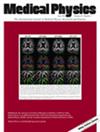Patient-specific modeling of radiation-induced lymphopenia for head and neck cancer
Abstract
Background
Radiation-induced lymphopenia (RIL) is a frequent complication in head and neck cancer (HNC) patients undergoing radiotherapy (RT), and its severity is associated with poorer survival outcomes.
Purpose
This work aims to develop a patient-specific modeling method to simulate lymphocyte kinetics during and after RT and evaluate the lymphocyte-sparing effects across different RT treatment regimens.
Methods
A cohort of 17 HNC patients receiving unilateral irradiation with protons or photons were included in this study. The dose to circulating lymphocytes was calculated using the HEDOS model, considering lymph nodes on the irradiated side, the esophagus, auto-segmented bilateral carotid arteries and jugular veins, skeletal muscle, fat, skin, compact bone, spongy bone, red marrow, and other skeleton. A patient-specific model was developed to simulate lymphocyte kinetics that account for radiation-induced damage to both circulating lymphocytes and lymph nodes. The weekly absolute lymphocyte counts (ALC) before, during and after RT, were assembled to estimate the patient-specific parameters. Four different RT treatment regimens—conventional fractionation, hypofractionation, stereotactic body radiotherapy (SBRT), and FLASH—were evaluated to compare their lymphocyte-sparing effects.
Results
Patients treated with protons had 17.1% less grade 3 and 4 RIL compared to photons. The mean dose to circulating lymphocytes was 1.28 ± 0.37 Gy(RBE) for proton therapy and 3.12 ± 0.75 Gy for photon therapy. The patient-specific model captured three distinct patterns of ALC kinetics: plateau phase, normal recovery, and incomplete recovery, with a mean squared error (MSE) of 0.024 ± 0.025 (mean ± SD) between the simulated and observed ALC values. On average, 42.72% of circulating lymphocytes received more than 0.1 Gy(RBE) in proton FLASH, significantly less than the 81.94% in photon FLASH. Hypofractionated RT, SBRT, and FLASH were 6.5%, 20.2%, and 29.9%, respectively, higher than conventional RT in term of ALC levels 3 months post-RT. At 1 year post-RT, most patients achieved at least 70% recovery of baseline ALC for all treatment regimens.
Conclusion
A patient-specific method has been developed for modeling lymphocyte dynamics over the course of RT and the subsequent follow-up period for HNC patients.

 求助内容:
求助内容: 应助结果提醒方式:
应助结果提醒方式:


